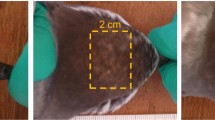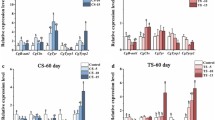Abstract
Melanins form the basis of animal pigmentation. When the sulphurated form of melanin, termed pheomelanin, is synthesized, the sulfhydryl group of cysteine is incorporated to the pigment structure. This may constrain physiological performance because it consumes the most important intracellular antioxidant (i.e., glutathione, GSH), of which cysteine is a constitutive amino acid. However, this may also help avoid excess cysteine, which is toxic. Pheomelanin synthesis is regulated by several genes, some of them exerting this regulation by controlling the transport of cysteine in melanocytes. We investigated the possibility that these genes are epigenetically labile regarding protein intake and thus contribute to cysteine homeostasis. We found in the Icelandic population of gyrfalcon Falco rusticolus, a species that pigments its plumage with pheomelanin, that the expression of a gene regulating the export of cystine out of melanosomes (CTNS) in feather melanocytes of developing nestlings increases with food abundance in the breeding territories where they were reared. The expression of other genes regulating pheomelanin synthesis by different mechanisms of influence on cysteine availability (Slc7a11 and Slc45a2) or by other processes (MC1R and AGRP) was not affected by food abundance. As the gyrfalcon is a strict carnivore and variation in food abundance mainly reflects variation in protein intake, we suggest that epigenetic lability in CTNS has evolved in some species because of its potential benefits contributing to cysteine homeostasis. Potential applications of our results should now be investigated in the context of renal failure and other disorders associated with cystinosis caused by CTNS dysfunction.



Similar content being viewed by others
References
Bellomo F, Corallini S, Pastore A, Palma A, Laurenzi C, Emma F, Taranta A (2010) Modulation of CTNS gene expression by intracellular thiols. Free Rad Biol Med 48:865–872
Chiaverini C, Sillard L, Flori E, Ito S, Briganti S, Wakamatsu K, Fontas E, Berard E, Cailliez M, Cochat P et al (2012) Cystinosin is a melanosomal protein that regulates melanin synthesis. FASEB J 26:3779–3789
Chintala S, Li W, Lamoreux ML, Ito S, Wakamatsu K, Sviderskaya EV, Bennett DC, Park YM, Gahl WA, Huizing M et al (2005) Slc7a11 gene controls production of pheomelanin pigment and proliferation of cultured cells. Proc Natl Acad Sci USA 102:10964–10969
Conrad M, Sato H (2012) The oxidative stress-inducible cystine/glutamate antiporter, system x −c : cystine supplier and beyond. Amino Acids 42:231–246
Galván I, Jorge A (2015) The rusty plumage coloration of juvenile gyrfalcons is produced by pheomelanin and its expression is affected by an intracellular antioxidant. J Raptor Res 49:59–65
Galván I, Solano F (2016) Bird integumentary melanins: biosynthesis, forms, function and evolution. Int J Mol Sci 17:520
Galván I, Mousseau TA, Møller AP (2011) Bird population declines due to radiation exposure at Chernobyl are stronger in species with pheomelanin-based coloration. Oecologia 165:827–835
Galván I, Ghanem G, Møller AP (2012) Has removal of excess cysteine led to the evolution of pheomelanin? BioEssays 34:565–568
Galván I, Bonisoli-Alquati A, Jenkinson S, Ghanem G, Wakamatsu K, Mousseau TA, Møller AP (2014) Chronic exposure to low-dose radiation at Chernobyl favours adaptation to oxidative stress in birds. Funct Ecol 28:1387–1403
Galván I, Inácio A, Romero-Haro AA, Alonso-Alvarez C (2017) Adaptive downregulation of pheomelanin-related Slc7a11 gene expression by environmentally induced oxidative stress. Mol Ecol 26:849–858
García-Borrón JC, Olivares Sánchez MC (2011) Biosynthesis of melanins. In: Borovanský J, Riley PA (eds) Melanins and melanosomes: biosynthesis, biogenesis, physiological, and pathological functions. Wiley-Blackwell, Weinheim, pp 87–116
Harrison F, Yeagy BA, Rocca CJ, Kohn DB, Salomon DR, Cherqui S (2013) Hematopoietic stem cell gene therapy for the multisystemic lysosomal storage disorder cystinosis. Mol Ther 21:433–444
Hearing VJ (2011) Genetics of melanosome structure and function. In: Borovanský J, Riley PA (eds) Melanins and melanosomes: biosynthesis, biogenesis, physiological, and pathological functions. Wiley-Blackwell, Weinheim, pp 323–341
Hubbard JK, Uy JAC, Hauber ME, Hoekstra HE, Safran RJ (2010) Vertebrate pigmentation: from underlying genes to adaptive function. Trends Genet 26:231–239
Ito S, Nakanishi Y, Valenzuela RK, Brilliant MH, Kolbe L, Wakamatsu K (2011) Usefulness of alkaline hydrogen peroxide oxidation to analyze eumelanin and pheomelanin in various tissue samples: application to chemical analysis of human hair melanins. Pigment Cell Melanoma Res 24:605–613
Johnson JA, Ambers AD, Burnham KK (2012) Genetics of plumage color in the Gyrfalcon (Falco rusticolus): analysis of the melanocortin-1 receptor gene. J Hered 103:315–321
Karell P, Ahola K, Karstinen T, Valkama J, Brommer JE (2011) Climate change drives microevolution in a wild bird. Nat Commun 2:208
Klasing KC (1998) Comparative avian nutrition. CAB International, Wallingford
Lalueza-Fox C, Römpler H, Caramelli D, Stäubert C, Catalano G, Hughes D, Rohland N, Pilli E, Longo L, Condemi S et al (2007) A melanocortin 1 receptor allele suggests varying pigmentation among Neanderthals. Science 318:1453–1455
Liem EB, Hollensead SC, Joiner TV, Sessler DI (2006) Women with red hair report a slightly increased rate of bruising but have normal coagulation tests. Anesth Analg 102:313–318
Lin SJ, Foley J, Jiang TX, Yeh CY, Wu P, Foley A, Yen CM, Huang YC, Cheng HC, Chen CF et al (2013) Topology of feather melanocyte progenitor niche allows complex pigment patterns to emerge. Science 340:1442–1445
Mohanty S, Kumar A, Dhawan J, Sreenivas V, Gupta S (2011) Noncultured extracted hair follicle outer root sheath cell suspension for transplantation in vitiligo. Br J Dermatol 164:1241–1246
Nadeau NJ, Minvielle F, Ito S, Inoue-Murayaina M, Gourichon D, Follett SA, Burke T, Mundy NI (2008) Characterization of Japanese quail yellow as a genomic deletion upstream of the avian homolog of the mammalian ASIP (agouti) gene. Genetics 178:777–786
Nielsen ÓK (2003) The impact of food availability on gyrfalcon (Falco rusticolus) diet and timing of breeding. In: Thompson DBA, Redpath SM, Fielding AH, Marquiss M, Galbraith CA (eds) Birds of prey in a changing environment. Scottish Natural Heritage, Edinburgh, pp 283–302
Panzella L, Leone L, Greco G, Vitiello G, D’errico G, Napolitano A, d’Ischia M (2014) Red human hair pheomelanin is a potent pro-oxidant mediating UV-independent contributory mechanisms of melanomagenesis. Pigment Cell Melanoma Res 27:244–252
Park S, Imlay JA (2003) High levels of intracellular cysteine promote oxidative DNA damage by driving the Fenton reaction. J Bacteriol 185:1942–1950
R Core Team (2017) R: a language and environment for statistical computing. R Foundation for Statistical Computing, Vienna
Robert SM, Buckingham SC, Campbell SL, Robel S, Holt KT, Ogunrinu-Babarinde T, Warren PP, White DM, Reid MA, Eschbacher JM et al (2015) SLC7A11 expression is associated with seizures and predicts poor survival in patients with malignant glioma. Sci Transl Med 7:289ra86
Scott MC, Suzuki I, Abdel-Malek ZA (2002) Regulation of the human melanocortin 1 receptor expression in epidermal melanocytes by paracrine and endocrine factors and by ultraviolet radiation. Pigment Cell Melanoma Res 15:433–439
Stipanuk MH, Dominy JE Jr, Lee J-I, Coloso RM (2006) Mammalian cysteine metabolism: new insights into regulation of cysteine metabolism. J Nutr 136:1652S–1659S
Stipanuk MH, Ueki I, Dominy JE Jr, Simmons CR, Hirschberger LL (2009) Cysteine dioxygenase: a robust system for regulation of cellular cysteine levels. Amino Acids 37:55–63
Viña J, Saez GT, Wiggins D, Roberts AFC, Hems R, Krebs HA (1983) The effect of cysteine oxidation on isolated hepatocytes. Biochem J 212:39–44
Wang H, Osseiran S, Igras V, Nichols AJ, Roider EM, Pruessner J, Tsao H, Fisher DE, Evans CL (2016) In vivo coherent Raman imaging of the melanomagenesis-associated pigment pheomelanin. Sci Rep 6:37986
Weyrich LS, Duchene S, Soubrier J, Arriola L, Llamas B, Breen J, Morris AG, Alt KW, Caramelli D, Dresely V et al (2017) Neanderthal behaviour, diet, and disease inferred from ancient DNA in dental calculus. Nature 544:357–361
Xu X, Dong GX, Hu XS, Miao L, Zhang XL, Zhang DL, Yang HD, Zhang TY, Zou ZT, Zhang TT et al (2013) The genetic basis of white tigers. Curr Biol 23:1031–1035
Acknowledgements
Two anonymous reviewers made useful suggestions that improved the manuscript. Sara Borrego and Rafael Márquez helped with laboratory analyses and Ólafur H. Nielsen, María Nielsen, Einar Þorleifsson and Kristinn P. Magnússon with fieldwork. ÓKN has state permit to access gyrfalcon nests, ring chicks and to collect non-invasive genetic samples. IG is supported by a Ramón y Cajal Fellowship (RYC-2012-10237) and the Project CGL2015-67796-P, both from the Spanish Ministry of Economy and Competitiveness (MINECO).
Author information
Authors and Affiliations
Contributions
IG conceived and designed this study, conducted laboratory work, analyzed the data and wrote the manuscript. ÂI designed gene primers and participated in laboratory work. ÓKN conducted fieldwork.
Corresponding author
Ethics declarations
Conflict of interest
The authors declare that they have no conflict of interest.
Statement of animal rights
All applicable institutional and/or national guidelines for the care and use of animals were followed.
Additional information
Communicated by Indrikis Krams.
Electronic supplementary material
Below is the link to the electronic supplementary material.
Rights and permissions
About this article
Cite this article
Galván, I., Inácio, Â. & Nielsen, Ó.K. Gyrfalcons Falco rusticolus adjust CTNS expression to food abundance: a possible contribution to cysteine homeostasis. Oecologia 184, 779–785 (2017). https://doi.org/10.1007/s00442-017-3920-6
Received:
Accepted:
Published:
Issue Date:
DOI: https://doi.org/10.1007/s00442-017-3920-6




